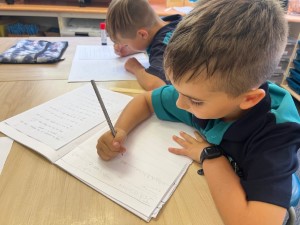Writing in Prep to Year 2
Writing in Prep to Year 2
What is writing?
Writing is a process of using letters, words and sentences to communicate thoughts and ideas. Even though it might look simple, it requires the synthesis and application of many understandings and skills. Even when writing a note to a friend, the author needs to consider the ideas to be communicated, the structure and sentences that suit the purpose, the correct letters and sounds, how to form the letters and where to include punctuation – all to make sure that the message is communicated effectively.
Why is it so important?
Writing provides an important way to communicate our ideas, and in doing so we can entertain, inform and persuade others. As we write, we sort our thoughts and learn new things. It is a way to express what we have learned but also a way to express who we are, our interests and our ideas. It makes our thinking visible and at school and throughout higher education, writing is used by others to judge our understandings of topics.
What does learning to write look like?
The best way to learn to write, or to become a better writer, is to write. In the early years of school, this is done through real-life and life-like situations as children experiment with drawing and writing and build their confidence.
Each term students are supported to create a specific written text as part of their English unit of work. For example, they might create a poster persuading others to read their favourite picture book, construct a written retell of a familiar fairy tale, or write a description of a favourite place. Students are also provided with an opportunity to create texts of their own choice during Daily 5 Café activities, focusing on creativity, artistry, fun and enjoyment.
How do we know that children are progressing?
Teachers analyse samples of writing at the beginning (pre-test) and end of each English unit, as well as providing feedback throughout the learning phase. Teachers provide feedback in relation to Writing scales and criteria sheets, developed specifically for each writing task. In this way teachers and students know the ‘next steps’.
What can you do to support writing at home?
 Draw attention to writing in the world (e.g., signs, posters, notes, advertisements, labels).
Draw attention to writing in the world (e.g., signs, posters, notes, advertisements, labels).- Find everyday opportunities to tell and share stories (e.g., after visiting relatives, when something funny happens), encouraging some ‘tall tales’ and exaggerated events.
- Play with language, sharing your ideas and encouraging everyone to participate (e.g., silly rhymes and puns on words, new poems or stories with characters from your family).
- Find everyday opportunities to write (e.g., shopping lists, birthday cards, postcards, drawings, diaries, notes in lunchboxes, writing games where everyone writes a part of a story).
- Use a range of writing implements to build confidence and strength in young writers’ hands (e.g., pens, pencils, chalk, whiteboard pens, paint, coloured paper, scissors, glue, stickers).
Mrs Sue Zweck, Head of Learning K-5
